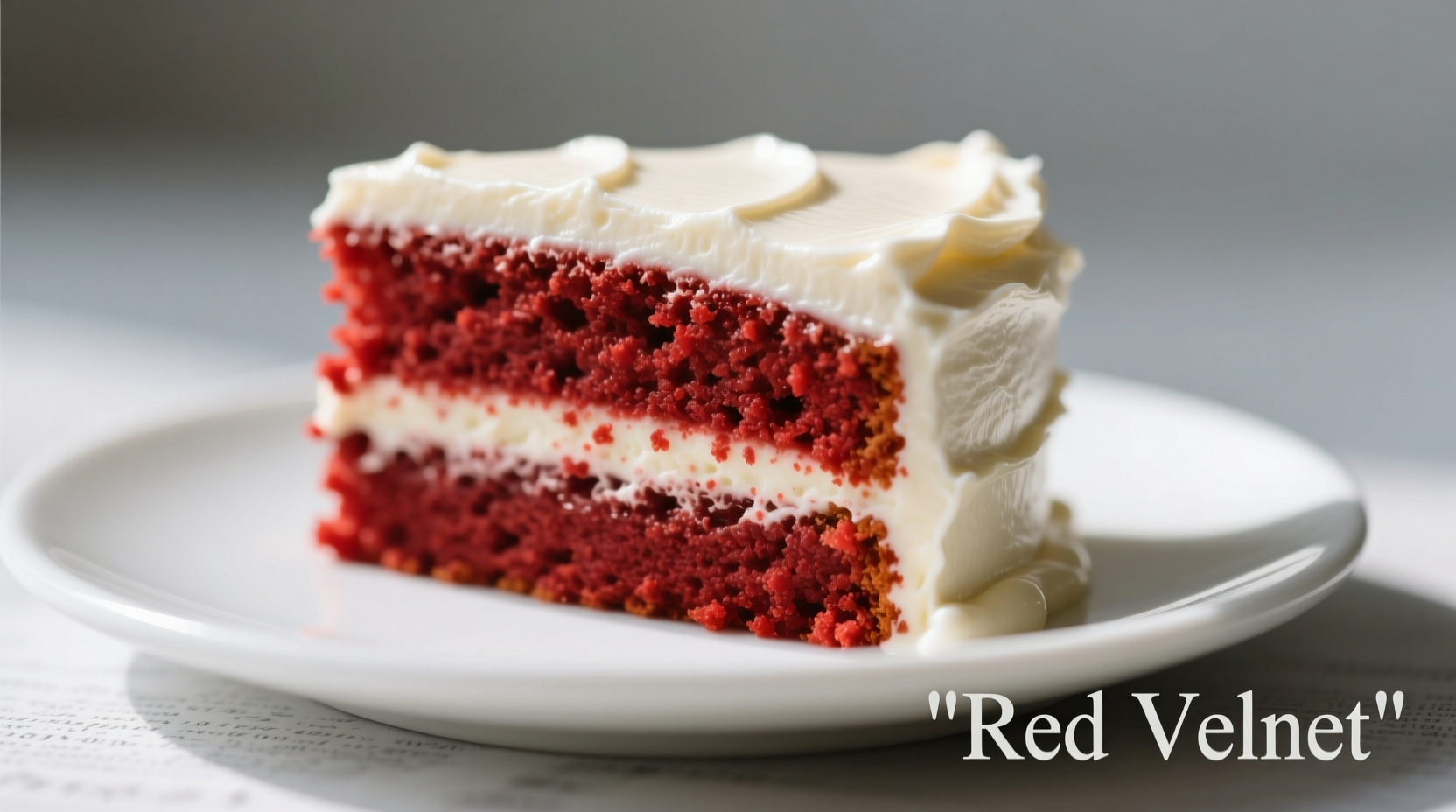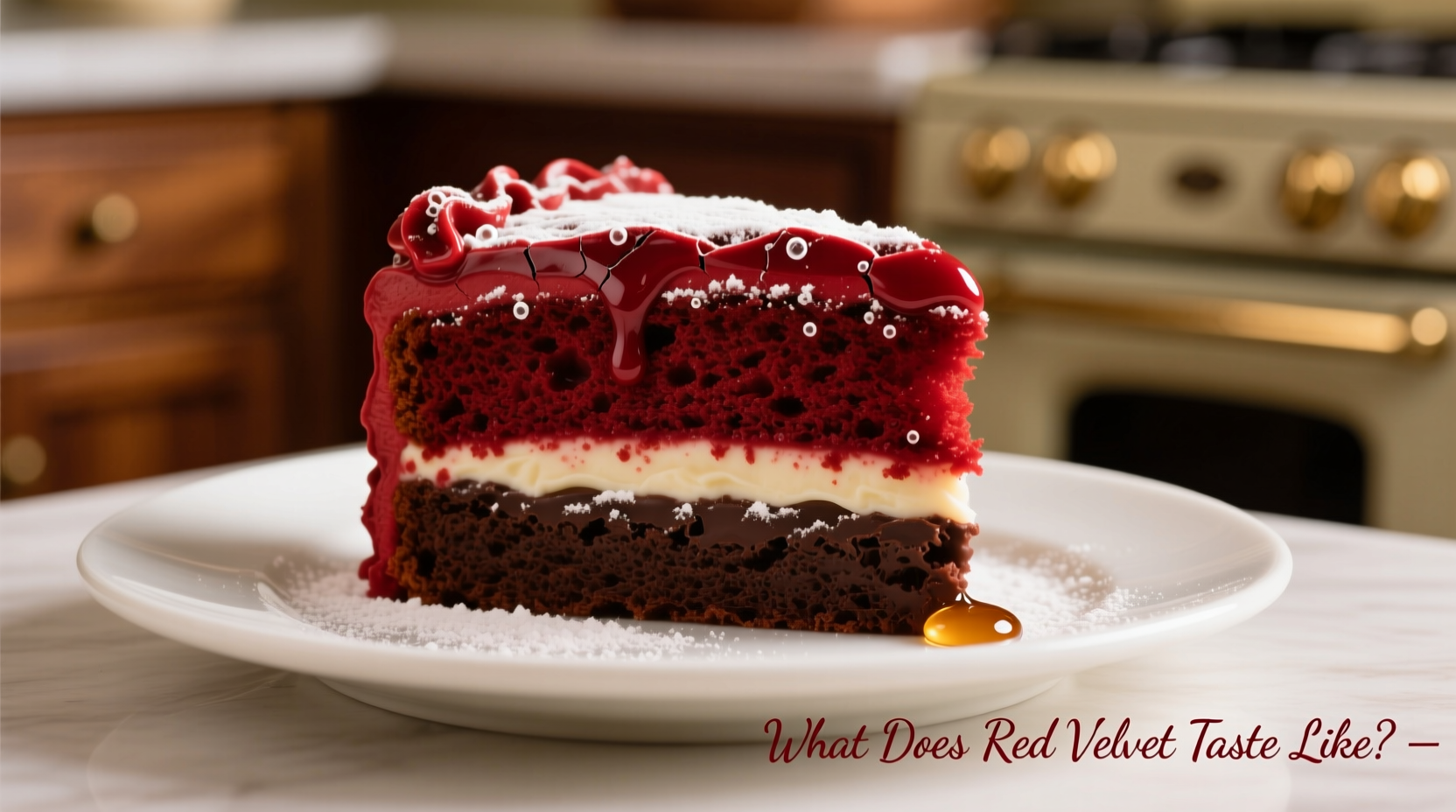If you’ve ever wondered what does red velvet taste like beyond its striking color, you’re not alone. Many people mistakenly assume it’s just chocolate cake with red food coloring, but the reality is far more nuanced. This iconic dessert offers a sophisticated flavor experience that’s become a staple in bakeries and home kitchens worldwide.
The Science Behind Red Velvet’s Distinctive Flavor
Red velvet’s unique taste stems from a precise chemical reaction between key ingredients. The traditional recipe combines cocoa powder, buttermilk, and vinegar—a combination that creates both visual and flavor magic. When the acidic buttermilk and vinegar interact with the cocoa’s anthocyanins (natural pH-sensitive pigments), they produce the cake’s characteristic deep red hue while simultaneously developing complex flavor compounds.
According to food science research from the USDA National Institute of Food and Agriculture, this reaction doesn’t just affect color—it transforms the flavor profile by breaking down certain compounds in the cocoa, resulting in a milder chocolate taste with subtle fruity undertones. This explains why red velvet never tastes as intensely chocolatey as a standard chocolate cake.
Red Velvet vs. Chocolate Cake: Clearing the Confusion
One of the most common misconceptions is that red velvet is simply chocolate cake with red dye added. Let’s examine the key differences that affect what red velvet cake tastes like compared to traditional chocolate cake:
| Characteristic | Red Velvet Cake | Traditional Chocolate Cake |
|---|---|---|
| Cocoa Content | 1-2 tablespoons (small amount) | 3/4 to 1 cup (substantial amount) |
| Primary Flavor Notes | Mild cocoa, buttermilk tang, creamy sweetness | Rich, deep chocolate, sometimes bitter |
| Texture | Finer crumb, slightly denser | Softer, more open crumb structure |
| Acidic Components | Buttermilk + vinegar (essential) | Rarely includes vinegar |
| Classic Frosting | Cream cheese (complements tang) | Chocolate buttercream or ganache |
How Red Velvet Evolved: A Flavor Timeline
Understanding what does red velvet taste like today requires examining its historical development. Food historians from the North Carolina State University Food Research Library have documented how the flavor profile evolved:
- Early 1800s: The term "velvet" referred to fine-textured cakes made with cocoa and buttermilk, naturally developing a reddish hue from non-alkalized cocoa
- 1900-1930s: The Waldorf-Astoria recipe popularized the modern version, using beets for natural coloring and flavor complexity
- 1940s-1950s: Artificial red dye replaced beets during WWII rationing, changing the flavor profile slightly
- 1989: The Steel Magnolias film sparked renewed interest, cementing cream cheese frosting as essential to the complete flavor experience
- Present Day: Most commercial versions use artificial coloring, but premium bakeries often return to natural ingredients for better flavor balance
What Affects Red Velvet’s Flavor Profile?
Several factors determine what red velvet tastes like in different preparations. As a professional chef with experience in both fine dining and casual settings, I’ve observed these critical variables:
Ingredient Quality Matters Most
The quality of your cocoa powder significantly impacts flavor. Natural (non-Dutched) cocoa produces the authentic red velvet taste because it’s more acidic and contains the anthocyanins needed for both color and flavor development. Dutch-processed cocoa creates a darker, more chocolate-forward flavor that misses the mark.
The Frosting Factor
Many people don’t realize that cream cheese frosting isn’t just traditional—it’s essential to the complete flavor experience. The tangy cream cheese balances the cake’s subtle acidity, creating a harmonious flavor profile. Buttercream frosting creates an entirely different (and less authentic) taste experience.
Baking Technique Influences Flavor
Overmixing the batter develops too much gluten, resulting in a tough texture that distracts from the delicate flavor. The ideal red velvet has a fine, velvety crumb that melts in your mouth—hence the name. Temperature control during baking also affects how the cocoa compounds develop.
Regional Variations and Their Flavor Impact
While red velvet originated in the American South, regional adaptations have created distinct flavor interpretations. Understanding these differences helps answer what does red velvet taste like across various contexts:
- Traditional Southern: Mild cocoa flavor with pronounced buttermilk tang, often made with natural cocoa and minimal food coloring
- Modern Commercial: Stronger red color with more artificial flavor notes, sometimes overcompensating with excessive cocoa
- Caribbean-Inspired: Incorporates spices like cinnamon and allspice, adding warmth to the flavor profile
- Artisanal Versions: Often use beets or pomegranate for natural coloring, adding subtle earthy or fruity notes
Food anthropologists at Smithsonian Magazine note that these regional variations reflect cultural preferences—Southern versions prioritize subtlety while commercial versions often amplify both color and flavor to meet consumer expectations.
When Red Velvet Tastes “Off”: Common Flavor Problems
Not all red velvet experiences are positive. Here’s what to watch for when evaluating what red velvet should taste like:
- Overpowering artificial flavor: Cheap food dyes can create a chemical aftertaste that overwhelms the delicate balance
- Too much cocoa: Some bakeries add excessive cocoa to compensate for using Dutch-processed cocoa, creating a muddy chocolate flavor
- Missing acidity: Omitting vinegar or buttermilk destroys the chemical reaction, resulting in flat flavor and poor texture
- Imbalanced frosting: Overly sweet buttercream instead of tangy cream cheese creates cloying sweetness that masks the cake’s nuances

How to Experience Authentic Red Velvet Flavor
To truly appreciate what red velvet tastes like, follow these professional tips:
- Start with a small bite: Let the cake sit on your tongue for 5 seconds before chewing to experience the full flavor development
- Notice the progression: First the creamy sweetness, then subtle cocoa notes, finishing with a delicate buttermilk tang
- Pair with coffee: A medium-roast coffee complements rather than competes with the nuanced flavors
- Check the texture: Authentic red velvet should have a fine, velvety crumb that dissolves easily
- Consider the temperature: Slightly chilled (not cold) enhances the flavor complexity
Remember that the complete red velvet experience involves both the cake and its traditional cream cheese frosting—they’re designed to work together. When properly executed, red velvet offers a sophisticated flavor journey that’s become beloved for good reason.











 浙公网安备
33010002000092号
浙公网安备
33010002000092号 浙B2-20120091-4
浙B2-20120091-4